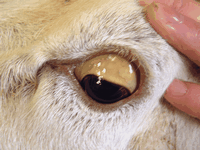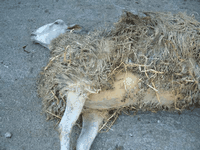NADIS Disease Focus for Scotland – September 2006
| NADIS is a network of 40 veterinary practices and six veterinary colleges monitoring diseases of cattle, sheep and pigs in the |
| NADIS disease bulletins are written specifically for farmers, to increase awareness of prevalent conditions and promote disease prevention and control, in order to benefit animal health and welfare. Farmers are advised to discuss their individual farm circumstances with their veterinary surgeon. |
There were several NADIS reports of copper poisoning in sheep during the summer. This is by far the most common poisoning reported in sheep, with a significant variation between breeds in their susceptibility.
Two distinct syndromes are recognised: chronic copper toxicity which is commonly reported following long-term liver storage of dietary copper and acute copper toxicity which is occasionally reported following inaccurate administration of copper injections.
Chronic Copper Poisoning
Chronic copper poisoning occurs after the sheep’s liver capacity for copper storage has been exceeded. This results in sudden release of copper into the circulation, causing liver damage, destruction of red blood cells and jaundice.
There is variation in breed susceptibility to copper toxicity related to ability to absorb dietary copper.
North Ronaldsay, Texel, Suffolk and several continental short-wool breeds of sheep are relatively susceptible, when compared with, for example, Cheviots and Scottish Blackfaces.
Growing lambs are more susceptible than adult ewes. Clinical signs are sudden in onset and affected animals become increasingly weak, often wandering aimlessly or head-pressing. Urine often appears black due to red blood cell breakdown.
Later, jaundice develops and breathing becomes shallow and rapid due in part to anaemia.


Most animals die following a short period of Jaundice of the sclera of the eyerecumbency. Note yellow coloured skin
The diagnosis of copper poisoning is based on the housing and feeding history, clinical signs and post-mortem findings of a pale tan to bronze-coloured liver and dark red or black kidneys. The diagnosis can be confirmed by laboratory identification of high kidney copper concentrations.
Management of outbreaks of chronic copper poisoning
As response to treatment of clinical cases is poor, resources should be directed towards identification of the underlying causes of the problem and the prevention of clinical disease in the remaining at-risk animals.
Oral dosing or subcutaneous injection of ammonium tetrathiomolybdate will ‘strip’ copper from the liver, although recently this has become prohibitively expensive other than for very valuable animals.
Copper antagonists such as molybdenum or sulphur can be added to the ration to prevent further liver accumulation of copper. Your vet can provide more precise information about the management of copper poisoning.
Prevention depends on avoiding feeding copper-rich diets to susceptible animals. Breed, age (young animals absorb copper very efficiently) and the presence of dietary copper antagonists such as iron, sulphur and molybdenum all influence the efficiency of absorption.
Feeds with high concentrations of available copper include –
- Pasture, silage and root crops grown on ground to which large quantities of pig or poultry manure has been applied.
- Distillery by-product feeds such as distiller’s dark grains produced from copper stills. Concentrate feeds containing palm oil or molassed sugarbeet pulp. (Whole grain cereals are relatively poor sources of copper.)
- Other potential sources of copper include; access to cattle minerals; copper sulphate foot baths; and fungicide-treated timber.
In the highly susceptible North Ronaldsay breed of sheep, or in intensively-managed housed sheep, poisoning can result from prolonged feeding of diets with relatively low copper concentrations.
Housed sheep should, therefore, not receive any form of copper supplementation before or during housing.
Acute Copper Poisoning
Acute copper poisoning occurs sporadically, usually following gross over dosage of injectable copper preparations used for prevention of deficiency syndromes.
Clinical signs are sudden in onset and non-specific and include depression, rapid heart and respiratory rates and subnormal rectal temperature. Blue/green-coloured diarrhoea is frequently present. Collapse and death usually follow within 24 hours.
| FURTHER INFORMATION | SPONSORED LINKS |
| Supporting British Livestock |  |
| To find out more about EBLEX | |
| To find out more about the HCC |  |
| To find out more about QMS |  |
